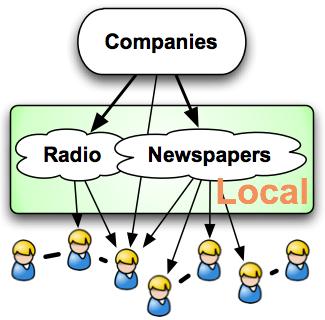Last week, I wrote a piece on brand building for Forbes.com. With permission, I am publishing the unedited version here.
 Today, marketing your business for free may seem to be an unattainable process. But with social media marketing, it doesn’t have to be. The only investment in the act of marketing on the social web is time and energy.
Today, marketing your business for free may seem to be an unattainable process. But with social media marketing, it doesn’t have to be. The only investment in the act of marketing on the social web is time and energy.
Thankfully, you don’t have to go at social media marketing alone. Engagement in a process called brand evangelism is one beneficial strategy to get your brand known and to help spread your message. Brand evangelism is a word of mouth marketing tactic in which the ardent supporters of your service or product feel so passionately about your offerings that they act as unofficial spokespeople on your company’s behalf. They are cheerleaders on the sidelines and they’re rooting for your team.
By listening to the conversations — the blog posts, the forum discussions, the tweets, and the other public dialogues — that relate to your brand, you can find out who feels strongly about your company and product, you can assess who might have a neutral stance toward your service, and you can gather information about your detractors those who dislike your current offerings. In a brand evangelism strategy, you’d take note of those who feel good about what you are doing: they already represent your target audience. As such, it would be foolish not to embrace them. Their citizen marketing can boost your credibility in the eyes of their peers who are hopefully your customers.
Spotting your brand ambassadors should not be too tricky. The easiest way to find these people is to find the communities that your users frequently visit, be it forums, Twitter, or other social networks. If you have a Facebook Fan page, look at what people are saying. Subscribe to service-specific alerts (e.g. get Twitter mentions of your brand via RSS or email) or use a service like Backtype (backtype.com) to see comments across blogs and other social media sites (such as FriendFeed). Google Alerts can also help you dig into the wider search space and may help you spot mentions of your company that may not otherwise be caught by other services. While seemingly overwhelming, there aren’t too many search services out there, and there isn’t one free solution that tracks every single mention of your brand. (Paid solutions, such as SocialRadar and Radian6, however, may eliminate this overhead.)
Once you gather these sources, begin by listening to what they are saying. Find out the users who can’t stop singing praises about you. (Find out about those who don’t like you and try to determine what is pushing them away.) Gather their usernames or contact information. You’ll need this to proceed.
Now you know who your brand loyalists are. These are people who are already loving who you are. Love them back. Offer them benefits that let them continue singing praises about your offerings. Sure, they might do this by themselves without your involvement, but embracing your supporters can keep them promoting you for much longer. Offer them free products, samples, or gifts. Shower them with discounts or monetary compensation. Provide them with inside information, such as your upcoming product line or new services to be launched. Non-disclosures may need to be signed and paperwork establishing a formal business relationship may need to be filed.
As part of the brand ambassador agreement, it is important to ensure that when you do embrace these brand evangelists, those marketing on your behalf are completely transparent and open about their involvement. Full disclosure of their representation as it relates to specific perks is important. This is especially true as the FTC plans to police sponsored conversations. Brand evangelism programs fall under the jurisdiction of sponsored content.
As for your detractors, take them under your wing as well. These individuals felt impacted by something that was associated with your company, so you can and should work with them where appropriate to nurture their perception about your company. In fact, the mere aspect of giving these individuals a voice and letting them know that you value their opinions — and even positive action showing that you have listened — can turn that perception around. What do you have to lose? It’s amazing what talking to people can do. Could you turn these people into brand ambassadors? Maybe.
Ultimately, there will be overhead “costs,” such as monitoring your evangelists’ representation of your brand. In some instances, depending on the type of role you want your evangelists to play, it may be necessary to train the individuals on your brand’s practices and culture so that they do not come across as clueless people being paid to promote you.
Therefore, you may want to have someone from your company to act as a point of contact for the ongoing brand ambassador engagement. This task can be delegated to a community manager who corresponds directly with the evangelists and distributes the special perks. The community manager should also keep an eye on the blog posts and other engagements made by those who partake in the brand evangelist program. Internally, the overhead is minimal; your “marketing” team has just been outsourced, clearing your company’s paid marketing team to work on more exciting projects.
One concern is the brand evangelist program itself. You may find yourself dealing with those who believe that brand evangelism is questionable and deceptive. While this holds true for sponsored programs, only a small minority of individuals have question such practices, and you likely will end up seeing returns on your investment despite this small bump. It’s up to you to determine whether you feel that it is something you are willing and able to participate in.
The benefits of brand evangelists programs may outweigh the cons, though. Taking your biggest supporters under your wing may cause them to come to your aid in the future, even when the brand ambassador program duration comes to an end. If you embrace a customer and show them how valuable you think you are, they may return that embrace and protect you when you need it.
Does brand evangelism work? In 2007, Royal Caribbean ran a campaign called Royal Champions, inviting 50 of its most vocal ardent supporters on cruises and to face-to-face meetings with company executives. The feedback was overwhelmingly positive, and there was much buzz from the happy participants. The company observed higher levels of word of mouth marketing from influential community members and have decided that this marketing tactic was worthwhile to their brand.
If you are looking for a fun way to empower your customers and encourage positive discourse, brand evangelism programs are a great way to promote your brand. Give your customers a voice in the communities where they already have influence. There’s not much to lose and a whole lot to gain.





I appreciate your focusing on the need for transparency when engaging brand evangelism. It would be great to seeing companies create effective disclosure statements and be proactive versus reactive to what the government might ultimately require.
I think that the bottom line is that marketing via social networks is not as free as it seems.
However, it is much more efficient than any other form of marketing.
Investing in a campaign that rewards your satisfied users to become your ambassadors is more cost effective than paying a sales agent with the added benefit that nobody likes a sales agent but we all love our friends.
Also, as you mention, turning an unsatisfied customer into a happy camper is just as important as taking care of your satisfied clients. A converted client is a more dramatic and trusted story which makes it more interesting on the social network.
For me it proved to be very valuable and it is definitely worth the time and energy invested in all the social media.
I don’t see anything new here. Lester Wunderman invented the idea of listening to your customers 60 years ago and thus invented direct response marketing…
Wonderful approach. Seems to me that in order to gain the benefits of Social Media Marketing tactics, traditional marketers must give up their need for control, especially of the metrics. The social media networks are systems — non-linear, fuzzy, powerful, organic systems. Systems evolve in unpredictable ways. Brand evangelists can be an engine that leverages almost immeasurable benefits within the social media sphere — but they must learn to be somewhat detached from the need to measure and control every short term outcome. It’s a leap of faith.
Howard, you’re right, it’s not really new. But it’s not quite “direct response marketing” either. A company uses its customers to do marketing for them — to obtain other customers. In that way, it’s not quite direct anymore, since the customers are the intermediaries.
Further, it doesn’t necessarily have a “call to action” or an “offer.” It’s merely customers talking about what they love about their provider. I can’t really say you’re using the right term here.
Creating passionate customers can also result in “organic” viral marketing. The importance of transparency for brand ambassadors is also hard to overstate.
Tamar, thank you for this post! I know it has been a long time since you posted this one, but I am new to social media and it has been very enlightening. I came across it because I am taking a class at Skillshare, and our curator shared this post with us. I actually ordered your book yesterday, so probably my question will be answered when I get it and read it (tomorrow), but I still wanted to ask you in regards to how to monitor where the conversations about your business are taking place. You mention here how to monitor the conversations in a few ways, but as I started exploring the possibilities I will accept I felt overwhelmed. I went looking for backtype, which does not seem to be functioning anymore, that led me to Backtweets. I can search up tweets there, but it will not let me set up alerts. I signed up for Twilert but yet have to find out how well that works…. Any thoughts on those two or better alternatives? I have already setup my Google Alerts, thanks for that, I guess I have to play with the settings bit to get them tuned. Any tips on how else I can monitor better the ongoing conversation? Also, I came across Hootsuite, is that a good tool to listen or to publish? I was a little bit under the impression Hootsuite is for a bit more large scale social media? Thank you 🙂
sorry for the huge delay! My comments were totally hiding through spam that wasn’t being appropriately filtered.
Personally, Google Alerts is more than adequate for my needs; I don’t do more than that for most purposes. 🙂
I use HootSuite all the time though, and I think the $5.99 plan is great.
Good luck!